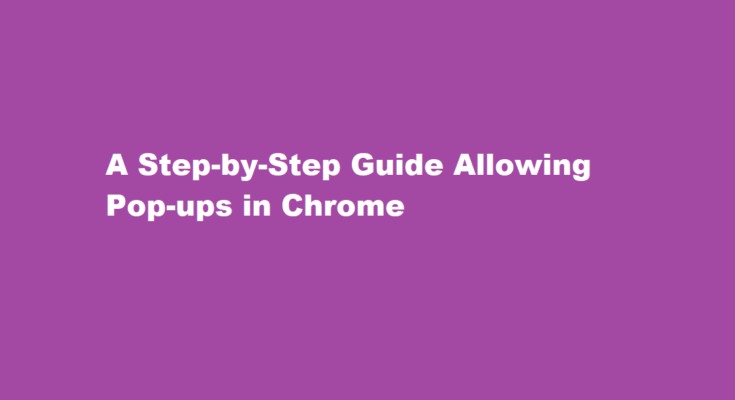Introduction
Pop-up windows are an essential feature of many websites, providing additional information or functionality. However, by default, Google Chrome blocks pop-ups to enhance user experience and security. In this article, we will walk you through the process of allowing pop-ups in Chrome, enabling you to access the content you need while maintaining a safe browsing environment.
Why Chrome Blocks Pop-ups
Google Chrome’s default setting to block pop-ups aims to protect users from potentially harmful or intrusive content. Pop-ups can be used for various purposes, including displaying advertisements, phishing attempts, or distributing malware. By blocking pop-ups, Chrome prevents users from unintentionally visiting unsafe websites or being bombarded with unwanted distractions. While this security feature is beneficial, it may occasionally interfere with legitimate pop-ups on trustworthy websites, requiring users to manually allow them.
Accessing Chrome’s Pop-up Settings
To begin, open Google Chrome on your computer. In the top-right corner, click on the three vertically-aligned dots to access the Chrome menu. From the drop-down menu, select “Settings.” Scroll down and click on “Privacy and security” in the left sidebar. Then, locate and click on “Site Settings.” Finally, under “Permissions,” click on “Pop-ups and redirects.” You are now ready to customize your pop-up settings according to your preferences.
Allowing Pop-ups for All Websites
If you want to enable pop-ups for all websites, toggle the switch beside “Blocked (recommended)” to turn it off. By doing this, Chrome will allow pop-ups from any site you visit. However, it is important to exercise caution since this may expose you to potentially harmful content. It is generally recommended to use this option sparingly and only for trusted websites or when necessary.
Allowing Pop-ups for Specific Websites
Chrome also allows you to customize pop-up settings for specific websites. In the “Pop-ups and redirects” settings, ensure the toggle switch is turned on for “Blocked (recommended).” Then, under “Allow,” click on “Add.” Enter the website’s URL in the text box and click on “Add” once again. This will whitelist the selected website, permitting its pop-ups. You can repeat this process for multiple websites. Remember to exercise caution when adding websites to the allowlist and ensure they are reputable and trustworthy.
Managing Exceptions and Notifications
Additionally, Chrome provides an option to manage exceptions and receive notifications about blocked pop-ups. By clicking on “Exceptions,” you can view and modify the list of websites for which pop-ups are allowed or blocked. This provides granular control over your browsing experience. Furthermore, Chrome can notify you whenever a pop-up is blocked, giving you the option to allow it temporarily or add it to the allowlist permanently.
FREQUENTLY ASKED QUESTIONS
Are pop-ups blocked on my browser?
Click the ellipsis icon (…) in the upper right corner of your web browser, and then click Settings. In the Advanced settings section, click View advanced settings. In the Block pop-ups section, click the switch to Off. Pop-ups are now allowed.
Why am I getting pop-ups on Google?
If you’re seeing some of these problems with Chrome, you might have unwanted software or malware installed on your computer: Pop-up ads and new tabs that won’t go away. Your Chrome homepage or search engine keeps changing without your permission. Unwanted Chrome extensions or toolbars keep coming back.
Conclusion
Pop-ups can serve a legitimate purpose on various websites, but Chrome’s default settings block them to protect users. By following the step-by-step guide outlined in this article, you can easily allow pop-ups in Chrome, granting access to desired content while maintaining a secure browsing environment. Remember to exercise caution when allowing pop-ups and only whitelist reputable websites to ensure a safe and enjoyable online experience.
Read Also : Decoding Corporate Culture Unveiling the DNA of Successful Organisations



